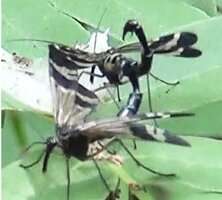Observing different mating tactics in the Japanese scorpionfly

Owing to the high competition and the prevalence of natural selection, many male insects must develop alternative tactics to mate with a female. Weaker males who lose in a competition (or loser males) may resort to hovering or sneaking around in order to find a mate. Recent studies have also shown that alternative mating behavior is influenced by environmental factors such as food availability, predation, and population density. For example, scorpionflies—which are often used to study the mating behavior of insects—use three alternative mating tactics—gifting nutritious saliva, gifting food, and forced mating—to obtain a mate. Male Japanese scorpionflies also employ feeding mating (i.e., mating while females feed without gifting them anything or releasing pheromones).
Previous studies looking at alternative mating tactics in scorpionflies have shown that the weaker males of closely-related species employ varying methods to procreate, however no research has been done to find the alternative mating tactics of males within the same species from different geographical locations. To this end, Dr. Ryo Ishihara (who is affiliated to the School of Agriculture and a recipient of the Special Educational and Research Fellowship) and Professor Takahisa Miyatake (from the Faculty of Environmental and Life Science) of Okayama University, Japan, published a study in the Journal of Ethology on 15 June 2022. This study details the differences in alternative mating tactics of Japanese scorpionflies hailing from two different places—the Aichi and Okayama prefectures in Japan.
"A recent study among scorpionflies from Okayama reported their mating behavior and I noticed the results were very different from those reported in previous studies among scorpionflies from Aichi. This piqued my curiosity, and I wanted to verify whether behavioral differences were really occurring between the two regions," said Dr. Ishihara, who takes an avid interest in entomology.
The researchers observed mating behaviors in a total of 25 males in Aichi, and 30 males almost 300 km away in Okayama, over a period of six hours in designated feeding areas. They noticed that one of the first behaviors in both the populations of loser males was waiting.
The loser males of Okayama resorted to "sneaking" back into the feeding area, where they positioned themselves near the food offered by the winner male as a nuptial gift and waited until another female arrived. They would then present the food as a nuptial gift and attempt to mate with this female. Of the 28 loser males who employing this tactic, 24 successfully mated. On the other hand, 17 males among the scorpionflies in Aichi ran away, seven were found "sneaking" (though even these scorpionflies left after one or two failed attempts at mating), and one attempted to forcefully mate with visiting females.
A significant number of defeated male scorpionflies from the Aichi population, the researchers concluded, chose to leave the feeding area while a majority of Okayama males preferred "sneaking" and trying to mate again. It was also noticed that the defeated males from Okayama waited longer than the ones from Aichi.
Why was this so?
"Well, there are certain factors that are thought to influence alternative mating in Japanese scorpionflies. One of these is the frequency and number of females visiting the feeding areas," Dr. Ishihara explains. Females in Okayama appeared more frequently and in greater numbers in feeding areas. As a result, defeated males waited longer and used "sneaking" tactics for successful mating with visiting females. The females in Aichi visited the feeding areas less frequently, leading to defeated males who looked for other feeding areas, or resorted to attempts at forceful mating.
The findings in the wild were corroborated with laboratory experiments. From these results, the researchers inferred that there is also a genetic component that influences alternative mating and courtship habits.
Dr. Ishihara emphasized the importance of the study and said, "This is the first example of two regionally different populations of the same species of scorpionfly showing variations in alternative mating tactics. Our research may be used to understand the long-term environmental indicators of habitat, predict the strength and direction of sexual selection, and identify early factors in the evolution of mating tactics."
More information: Ryo Ishihara et al, Differences in mating tactics performed by males of two local populations of the Japanese scorpionfly Panorpa japonica, Journal of Ethology (2022). DOI: 10.1007/s10164-022-00753-2
Provided by Okayama University




















